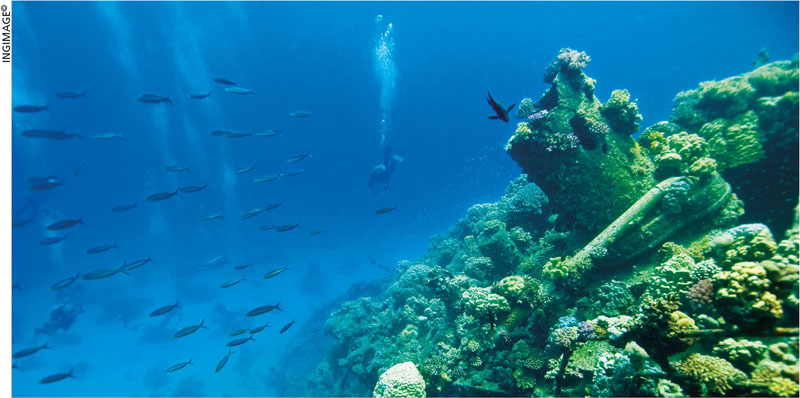MARITIME ARCHAEOLOGY
THE TREASURES OF SRI LANKA
The sunken ships off the coast are now rich in marine life – Janaka Perera
A good part of Sri Lanka’s heritage lies scattered on its seabed. Scores of ill-fated vessels have come to grief off the island’s coast over the centuries. In the 1960s, diver, biologist and journalist Rodney Jonklaas hit the headlines with his sensational discovery of a British warship that was over 200 years old, found off Elephant Island in Trincomalee.
Among his underwater findings were several large cannons and other nautical items including a small pilot anchor. Previously, he had found an ancient galleon off the island’s southeastern coast.
These undersea explorations inspired the making of the first Sinhala language colour film titled Ranmuthu Duwa (Island of Treasures), which was coproduced by Sir Arthur C. Clarke and Shesha Palihakkara in 1962.
In 1964, Sir Arthur and Mike Wilson (later Swami Siva Kalki) discovered a 17th century wreck of a Dutch vessel with a cargo of silver coins and a bronze cannon. The authorities promptly designated the site an archaeological reserve and the ship’s discovery marked the beginnings of Sri Lanka’s maritime archaeology.
Today, the Antiquities Ordinance No. 9 of 1940 prohibits any sunken vessel that’s older than 100 years and lying in our territorial waters to be salvaged, and any artefacts removed without a permit.
Having been a key trade and shipping port on the ancient Maritime Silk Route from China to Europe, shipwrecks abound in our coastal waters. The transformation of a sunken ship into a coral reef is amazing as it forms a viable component in marine ecology.
When a vessel sinks to the seabed, it becomes part of the oceanic environment and an abundance of aquatic life wraps around it over time, forming a framework and shelter that helps sustain a marine ecosystem. As time goes by, a shipwreck becomes richer in marine biodiversity.
According to records, over 200 shipwrecks are scattered around the coast of Sri Lanka. Many have been located and the search continues to this day with the aid of advanced resonance scanning technology. The high number of wrecks is attributed to around 500 years of trade, commerce, conflict and war during the Portuguese, Dutch and British periods, which resulted in a large volume of shipping traffic along our shores.
Among the most notable wrecks off the east coast is the British aircraft carrier HMS Hermes. Some 70 Japanese aircraft carrier-based bomber planes sent her to the bottom of the sea, killing over 300 crew on 9 April 1942. Four of its sister ships including the Australian destroyer HMAS Vampire also sank during the WWII attack and now lie close to the Hermes.
Lying in another watery grave is a Catalina flying boat that crashed off the Pasikudah coast in December 1943 while on a mission to destroy a Japanese submarine operating in the Bay of Bengal. Fortunately, its crew of 11 survived. Diver Darshana Jayawardena discovered the site.
Among the reasons for the east coast in general and Batticaloa in particular abounding in shipwrecks is successive cyclones that hit the island, and unleashed their fury in 1845, 1907, 1921 and 1978.
Before the railway was extended to Batticaloa, Walker Sons and Company operated a number of ships to ferry passengers and goods, and docked in Colombo, Point Pedro, Galle, Trincomalee and Hambantota. The cyclones wrecked several of these vessels, which were on the high seas at the time.
Close to the coast off Hikkaduwa, the British tanker Conch struck a reef at Akurala and the vessel – with a cargo of several thousand tons of bulk oil – broke in two and came to rest at a depth of 22 metres. The Conch was on a voyage from Colombo to South India and detritus of the shipwreck are scattered on the seabed.
The Norwegian ship MV Tricolor, which sank off our coast in 1931, is the deepest known shipwreck at about 65 metres. That vessel was meant to sail from Colombo to Yokohama but now lies about 15 kilometres west off Beruwela.
Off the coast of Galle and Ambalangoda, over 100 wrecks of stricken ships that were reported have been found. Famed for its extensive history and threefold colonial dominion, Galle was the second most important harbour of the Dutch East India Company (VOC) in Asia.
Some of the other famous sunken vessels that have been claimed by nature are the Earl of Shaftesbury off Hikkaduwa and SS Rangoon near Unawatuna.
In 2002, the Department of Archaeology and the Central Cultural Fund jointly carried out underwater exploration off the Galle Harbour. The exercise was funded by a grant from the Government of the Netherlands.
This project focussed on a Dutch ship, which sank near Galle Harbour over 400 years ago. The artefacts found included a woman’s skull – hardy enough to have stood the ravages of the eroding currents for the past four centuries.
Today, these ill-fated vessels on the seabed off our shores are fascinating repositories of erstwhile marine trade and commerce, as well as being flourishing marine ecosystems.





